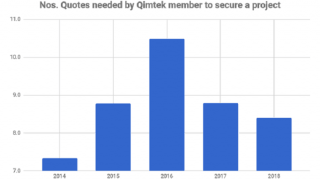
Chances are that if you’re not a seasoned sales professional, then the words ‘new business’ probably send a shiver down your spine. Let’s face it; nobody ever starts their own engineering company because they want to dedicate more time to sales - it’s usually seen as a necessary evil to facilitate both establishment and growth.
Sales and business development holds certain connotations and in this case, there is certainly no smoke without fire. It can be extremely disheartening to quote multiple companies with no success - sometimes you can be left feeling frustrated and completely unmotivated to continue. But why are we so quick to claim failure against an unknown metric? And how long is the sales cycle anyway?
Statistics of the Sales Cycle:
By reviewing our own data, we can see that the number of ‘first contact’ quotes our members have to submit to win a new customer fluctuates year by year. Starting at 7.4 in 2014, this figure then rose to 10.5 by 2016, before falling to 8.5 in 2018. The average over the five years is calculated as 8.8 - a figure that far exceeds the expectations of many companies who are left disappointed when they fail to win their first few jobs.
Just over 30% of these quotes later resulted in an order being placed in the months that followed - that is, that the supplier didn’t win the original job, but were later contacted by the buyer about completing alternative work on their behalf. This goes to show that not every unsuccessful quote is a ‘lost’ quote, but rather a pipeline for the future.
It’s also worth bearing in mind that these figures are probably lower than those for ‘organic’ sales methods, as Qimtek’s data focuses on the buyers using our sourcing service - a prerequisite being that they have an active requirement and are inviting subcontract suppliers to contact them to discuss it. The wider market is much more volatile from a sales perspective, as the cross-section of buyer interest is largely varied and inconsistent at any given time.
Understanding the Fluctuation:
Of course, external influences are always going to have a bearing on the conversion ratio, meaning that sometimes, the sales pool will be easier to navigate than others. A busy market will usually make for a smoother ride due to an abundance of work and less subcontract suppliers with capacity. On the other hand, a slower market will naturally lengthen the time taken to win new business, owing to the increased number of suppliers quoting for any given job.
Escalating uncertainty can also have a detrimental effect, as this is usually synonymous with tighter budgets and decreased spending. This could account for the hike experienced during 2016, which possessed a tense political climate in light of the Referendum.
Even with the use of distinguished sales techniques, it’s always good to remember that we are sometimes at the mercy of the market as a whole. No amount of experience will compensate for a lack of available work - only persistence and increased sales activity can overcome this obstacle.
Expectation vs. Reality:
Many business owners approach the new business arena with the same mindset they would adopt with their existing customer base. However, this breeds unrealistic expectations surrounding success and conversion rates, with many thinking that they will win most - if not every - job that they quote for.
When approaching a potential new client, it’s absolutely essential to remember that:
- The prospect does not know that you’re reliable.
- The prospect has never seen the quality of your work.
- The prospect does not have a full understanding of your capabilities.
- No personal relationship exists between yourself and the prospect (a factor which is largely underestimated when it comes to order allocation).
Therefore, it’s not only illogical to measure your new business and account management success with the same yardstick, but it’s also damaging. Many sales professionals will tell you that a positive mindset and mentality are invaluable, whilst a negative approach will almost certainly sabotage your chances of enticing a new customer.
Sales is - after all - a numbers game, essentially meaning that you have to be ‘in it to win it’. That’s not to say you’ll win everything - but by throwing in the towel and boycotting your new business efforts, you’ll be doing your company a disservice when success could be just around the next corner.
